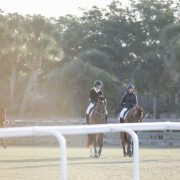Ranch Rehabs: In Praise Of The Cow Pony

By Shari Wilcox
While many adult amateurs dream of competing as a part of their horsing-while-adulting experience, the resources needed for purchasing, maintaining, training, and competing a suitable partner can seem well beyond reach.
Limitations on both time and funds create unique pressures to find horses that are financially accessible, but who can also cope with a limited or irregular training schedule without a budget-busting profusion of professional tune-ups. Whether your competitive aspirations are modest or grand, finding that unicorn in terms of financial accessibility, rideability, and suitability becomes essential.
And so, I offer this: consider horses of less traditional breeding for your chosen equestrian sport. Be they breeds not generally thought to be particularly skilled in a given discipline, those that are less common, or horses of unknown provenance, these horses can prove to be overlooked diamonds in the rough. With a keen eye, creative spirit, and a great deal of patience, you can find a suitable and enjoyable partner—particularly if you’re willing to be a bit of a disrupter and stand out in a crowd.
For me, working within these constraints has translated to a string of what I like to call “ranch rehabs”—Paint Horses that I’ve retrained and competed in eventing, jumpers, and classical dressage.
“Here’s the thing: I can afford my horse. I look forward to riding my horse, without the lurking dread of being over-mounted.”
My current cow pony, hailing from a long line of championship roping and cutting horses noted for their “cow sense,” fell into my hands after demonstrating a lack of aptitude for ranch work, an attitude incompatible with western pleasure, and flunking out of a lesson program by the ripe age of six.
By the time I met this ranch horse, he possessed a robust toolkit of work aversion techniques: refusing to move forward, bucking, spinning, and spooking became his ticket out of work with less experienced riders. Beneath all of this, I saw something different – a whisper of quality movement lurking in that shambling jog and a surprisingly uphill canter that belied classic Quarter Horse confirmation. I recognized a frustrated soul who needed a little space and a lot of quiet reassurance.
Pecos and I quickly fell into a rhythm. I’m thrilled to have a horse whose soundness and quieter manner I could depend on despite a schedule that only allowed for 3-4 days of training a week.
The sight of a rider on a Paint or Quarter Horse in dressage competition is not uncommon here in Texas given the ubiquity of the breeds. They remain more of a rarity in regional and national level classical dressage shows. Fellow competitors and spectators are often interested to learn more about these “nontraditional” mounts, and I have found judges to be particularly supportive in their comments and scoring.
Here’s the thing: I can afford my horse. I look forward to riding my horse, without the lurking dread of being over-mounted. In this failed cow pony, I found a dressage partner who could meet my modest amateur goals, and he found a space where he flourishes in a partnership with his rider.
The true rewards of our equine partnerships are, of course, not measured in lengths of satin. Selecting the right equine partner to fit the realities of your adult life with its challenges and demands is paramount. Shining up a diamond in the rough may be the most rewarding way to find your ride.
Photo by John Borys Photography


